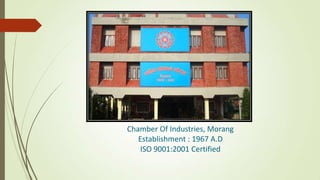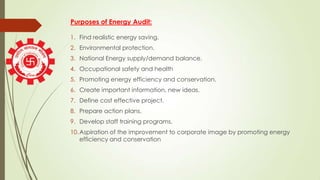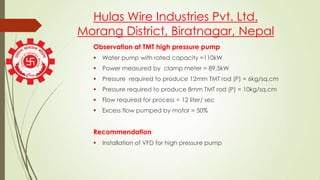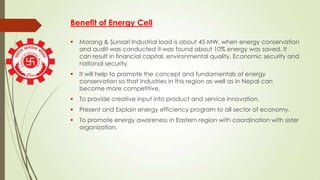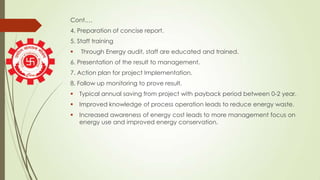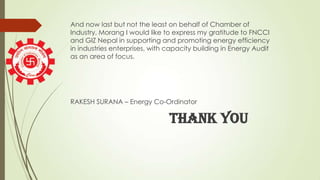Chamber of industry morang - Energy Efficiency
- 1. Chamber Of Industries, Morang Establishment : 1967 A.D ISO 9001:2001 Certified
- 2. INTRODUCTION Chamber of Industries Morang (CIM) is one of the leading chamber in Eastern Region. It was established in 2024 B.S. (1967 A.D) by one of the well-known Industrialist of Nepal with the aim of promoting Industries, develop national and International trade and commerce to achieve quality objectives, make necessary co- ordination with government and among Industrial sector. Chamber of Industries Morang plays a key role in promoting different activities like training, Workshop, Energy Conservation Program, Industrial trade fair, Seminar, Talk Programs and corporate social responsibilities.
- 3. Mission Develop national and international business, coordinate and regulate different activities establishing cooperation among the industries of the region. Vision Depicting proper industrial sector and encouraging industrialists and business personalities towards nation economic development. Objective To promote member industries, develop national and international trade & commerce, to achieve quality objectives, make necessary co-ordination among industrial sectors. 1. To co-ordinate among organizations and federations. 2. To protect industrial rights for mutual helps among national, international and local authorities. 3. To analyze and suggest annual policies, rules, plans for related member industries. 4. To participate actively in any conflict among industries and labor problem. 5. To organize regional, national & International seminar, talk program & workshop. 6. To open branch offices in all over Nepal if required for the protection of industries. 7. To flow information to the associated members and secretariat.
- 4. ENERGY AUDIT An energy audit is an examination of an energy consuming equipment/system to ensure that energy is being used efficiently. (Or) “Energy Audit” means the verification, monitoring and analysis of the use of energy including submission of technical report containing recommendation for improving energy efficiency with cost benefit analysis and an action plan to reduce energy consumption.
- 5. Purposes of Energy Audit: 1. Find realistic energy saving. 2. Environmental protection. 3. National Energy supply/demand balance. 4. Occupational safety and health 5. Promoting energy efficiency and conservation. 6. Create important information, new ideas. 7. Define cost effective project. 8. Prepare action plans. 9. Develop staff training programs. 10.Aspiration of the improvement to corporate image by promoting energy efficiency and conservation
- 6. Objective Energy audit is an effective energy management tools. By identifying and implementing the means to achieve energy efficiency & conservation, not only can save energy but also equipment/system life can be extended. All these means saving money. Based on the principle of “The less energy is consumed, the less fossil fuels will be burnt” so companies will generate relatively less pollutants and by- products. Therefore, all concerning these will contribute to conserve the environment and to enhance sustainable development. Environmental Protection Energy Audit = Saving Money + Sustainable Development
- 7. Classification Of Energy Conservation Measures Based on energy audit and analysis of the plant, a number of potential energy saving projects can be identified. These may be classified into three categories. No cost/Low cost – High return Medium cost- Medium return High cost- High return Normally the low cost - high return projects receive priority. Other projects have to be analyzed, engineered and budgeted for implementation in a phased manner.
- 8. Energy Audit In Few Industries within Morang and Sunsari Industrial Corridor Plant Energy Electrical – 567 KWh/ Ton of paper Thermal- 1 Ton of rice husk/ ton of paper Observation (Thermal) Heat loss from uninsulated boiler, digester and steam pipe Waste water- 47, 000 liter per hour Steam leakage- digester, resin cooker vessels
- 9. After Energy Audit Low cost high return (Thermal) Particulars Before After Surface Temperature (0 C) 180 50 Ambient Temperature (0 C) 30 30 Heat Loss (Kcal/yr) 269,325,000 22,572,000 Heat saved per year ( kCal) 46,753,000 Rice husk saved (tons/year) 78 Cost savings (Rs./year) 391,671 Total cost of insulation for 3 digesters (Rs.) 684,000 Simple payback period (years) 1.75
- 10. Observation (Electrical) 11kv supply 1000 KVA contract demand 1750 KVA transformer 0.73 PF Flat belt drive in paper machine Recommendation Improve power factor from 0.73 to 0.95 Replace flat belt drive to VFDs Lightening
- 11. Power factor Management Existing maximum demand Kva 628.82 Maximum Load 459.04 Measured powered factor 0.73 Improved power factor 0.96 KVAr required 110 KVA saving per month (NRs) 15066 Cost saving per month (NRs) 34,651.80 Cost saving per year (NRs) 415,821.60 Investment of 60 KVAr capacitor bank (NRs) 63,000.0 Simple pay back period 0.15 year (55 days)
- 12. VFD Application ID FD Rated power (KW) 56.25 37.5 Measured power (Kw) 14.5 12 Approx. power consumption(Kw) in presence os sand in fluidized bed 37 30 Energy consumed after implementation of VFD (KW) 25.9 21 Energy saving (KW) 11.1 9 Energy saving (KW) Working Hr-16, Number of days -300 53280(A) 43200(B) Saving (NRs) Average per unit cost is Rs- 5.8 309,024.0 250,560.0 Total A+B 559584 Investment 600,000.0 400,000.0 Total Investment 1,000,000.0 Pay back period 1.78 yrs
- 13. Lightning Consideration Amount saved = 3kw ×12 hrs × 5.8 × 300 = Nrs 62,640.0 per annum Note: Just few example of saving is mention here.
- 14. Hulas Wire Industries Pvt. Ltd. Morang District, Biratnagar, Nepal Observation at TMT high pressure pump Water pump with rated capacity =110kW Power measured by clamp meter = 89.5kW Pressure required to produce 12mm TMT rod (P) = 6kg/sq.cm Pressure required to produce 8mm TMT rod (P) = 10kg/sq.cm Flow required for process = 12 liter/ sec Excess flow pumped by motor = 50% Recommendation Installation of VFD for high pressure pump
- 15. VFD Application Power measured by clamp meter 89.5kW Power required for present flow with VFD installation 12kW Electrical Power saving 77.5kW Annual Electrical saving @ working 10 hr per day 279,000kwh Saving (NRs) @ Nrs 7 per unit 1,953,000 Investment required for VFD (Nrs) 600,000 Payback period 4 month
- 16. Observation at Combustion control in TMT Pusher furnace Oxygen content in flue gas was about 8 to 10% before recuperator resulting in dry flue gas loss about 17.53% During idle condition, 02 content in flue gas was about 14% Recommendation Reducing 02 percentage in flue gas down to 4% by controlling combustion blower damper Heat loss in dry flue gas 11.36% Reduction in % heat loss 6.2% Reduction in oil consumption (liter/hour) 35.35 Amount of furnace oil saving annually (KL) 127 Annual Saving (Nrs) 5,726,812 Investment in VFD and O indicator (Nrs) 500,000 Payback period 1 month
- 17. Benefit of Energy Cell Morang & Sunsari Industrial load is about 45 MW, when energy conservation and audit was conducted it was found about 10% energy was saved. It can result in financial capital, environmental quality. Economic security and national security. It will help to promote the concept and fundamentals of energy conservation so that Industries in this region as well as in Nepal can become more competitive. To provide creative input into product and service innovation. Present and Explain energy efficiency program to all sector of economy. To promote energy awareness in Eastern region with coordination with sister organization.
- 18. How Energy Cell will serve to Industries 1. Data collection and Analysis. Comparison with standard /Industrial best, average. Production data for industrial plants to find out operation improvement opportunities. 2. Site Investigation Discuss operation with site personnel, often they will know the energy use problems. Install energy monitoring where required to assess opportunities and to identify energy waste. 3. Cost and Benefit Analysis when conducting Feasibility study on energy saving projects cost and benefit analysis are essential
- 19. Cont.… 4. Preparation of concise report. 5. Staff training Through Energy audit, staff are educated and trained. 6. Presentation of the result to management. 7. Action plan for project Implementation. 8. Follow up monitoring to prove result. Typical annual saving from project with payback period between 0-2 year. Improved knowledge of process operation leads to reduce energy waste. Increased awareness of energy cost leads to more management focus on energy use and improved energy conservation.
- 20. Conclusion Energy audits, either walk-through or detailed energy audits, are essential for all sectors of the economy (including residential/tertiary sector buildings, School, College, Hotel, Hospital as well as industrial sector and transport companies) to promote a better understanding of the current status of end-use energy efficiency. The audits, which are usually coordinated by engineering or facility departments, will not only create awareness among those who are functionally involved in the management of energy but also justify the necessity for the implementation of energy efficiency activities.
- 21. And now last but not the least on behalf of Chamber of Industry, Morang I would like to express my gratitude to FNCCI and GIZ Nepal in supporting and promoting energy efficiency in industries enterprises, with capacity building in Energy Audit as an area of focus. RAKESH SURANA – Energy Co-Ordinator THANK YOU

